Among the radio Amateurs of many chess players. Many of them independently collect chess clock. However, improvised devices cannot be used on more or less serious competition, mainly because of their inconsistencies the requirements of FIDE. This situation is explained not so much by the complexity of the implementation the necessary algorithms for time tracking devices on the logical the circuits of low and medium degree of integration but ignorance the developers of the varieties of chess clocks and shown to him requirements. To bridge this gap, at the beginning of the proposed article describes the history of the chess clock, their classification and modes of operation.
Given that today in every office and many homes have computers, the author offers readers a program that implements all of the required from the electronic chess clock (ESC) function with a visual display of the situation on the screen, and tells of the design needed for this simple console to the computer.
An essential attribute of chess tournaments and matches - watch. The most ancient were sandy, they were replaced by mechanical, electrical, and, finally, electronic. Modern ESC is often called the "Fischer clock". To understand the reasons the appearance of this name, let us turn to history.
Once chess was played without time control. Happened, the player, once in a losing position, took the contender "on a starvation". The party lasted a lot hours, days. Luminaries managed to think over individual moves on a couple of hours. The straw of patience was the case international tournament of 1851, Judge of the party William-Mac low said entry: "the Party's not over both opponents fell asleep...".
Two years later in the match Garvis-Levental rivals for the first time limited in time, giving 10 minutes to think about each move. The clock was sand, each opponent. For exceeding the time limit has sought a monetary penalty. In 1866 in the match Anderssen-Steinitz hourglass replaced the mechanical, however, while not a regular chess, as usual.
Chess clock with two dials invented in 1883, the Englishman Thomas bright Wilson. Their design was far from modern, but allowed when stop a clock mechanism to start another. A year later, Amandus Shearwater received a patent for the industrial production of the chess clock. In 1886 they can be purchased in the shops of Liverpool. With 1899, in chess clock there was "the box", showing that before the expiration of the time limit is less than three minutes. The idea was proposed by D. B. Meyer. In Fig. 1 shows one of the earliest models chess clock company Ferranti.

The current prototype mechanical chess clock appeared in 1900 thanks improvements Veenhoff. Around the same time, the American Henry Warren invented the electric clock. Their chess variant went on sale in mid the 20-ies of the last century (Fig. 2).

The world's first ASC were made in Kiev in 1964, their Algorithm does not work different from classic tournament. For a long time ESC improved only in connection with the technological advances of electronics: replace the transistors came circuits, vacuum and gas-discharge indicators - led and LCD. Contributed and hams. Description several options homemade ESC can be found in [1-3], and in [4] is given scheme prefix turns in normal chess clock calculator.
But in the early 90-ies of the last century a steady flow of events broke American grandmaster Robert James Fischer - eleventh world champion chess. Coming out of a long period of seclusion, he once again surprised everyone, offering to play "Fischer random chess" by the clocks of Fisher".
For reference: "random chess Fischer" (Fischer Random Chess) are what is built, as usual, in the initial position of the figure before the game on lot of changing places. As a result, the horse may well be the Queen, rook - in the place of the elephant, etc. Instead of one only get 960 variantname seconds for each move made. If, considering the next move constantly to keep within this award, "check box" on the clock will never fall. Moreover, extra time may increase. Experienced chess players in such conditions bring any theoretically winning position to win.
My watch R. Fisher patented [5]. Unlike "random chess", they received the support of FIDE. A new method of time control was first applied on practice in the match Fischer-Spassky (1992). And since 1999 the "Official watch FIDE" (Official FIDE Digital Chess Timer, Fig. 3) in the "hours Fisher" is used in team chess Championships of Europe and world. In official hours provided and other interesting modes. 12, below, describes the main.
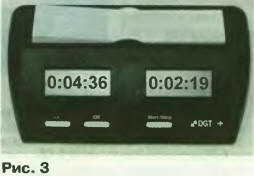
The delay time ("clock delay", Andante) - after each one of the contenders stroke timing his opponent begins immediately, but with delay, e.g., 5 C. If during this time the player will have time to make a move, it watch not change the indication Unspent prize time does not accumulate, therefore, the "superfast" game no benefits. This regulation common in tournaments held under the auspices of the American national chess Federation (USCF).
At zero delay time is not different from conventional mechanical chess clock. The disadvantage of "hours delayed" is considered the immutability of their testimony at a fairly quick game. The players is involuntarily associated with a malfunction of the clock mechanism.
Increase time without accumulation ("Bronstein clock", Adagio) - mode, equivalent to the above, but add no before and after move (arrow keys move backward). If a new move is made before expired "additive" before giving another, the clock will automatically return to its original state without additives.
A method was proposed in the 70 years of Soviet grandmaster D. Bronstein. Psychologically "Bronstein clock" attractive "hours delayed", as their values are constantly changing, convincing players in the health mechanism.
Increase time with accumulation ("Fischer's clock", "clock FIDE, bonus, progressive) - algorithm that is similar to "Bronstein clock", but unused prize time accumulates. Extra time after each move increases the set the number of seconds regardless of how much the player is thinking on this move. Series "ultra-fast" moves can save up enough for long time position analysis. Good or bad - chess theorists argue to this day.
Auxiliary modes ("watch for fun", "hourglass", "Gong") make ESC attractive to the consumer. At least think so manufacturers. Indeed, after a big party you can afford to relax and play, for example, when the time spent on think about the course is automatically added to the opponent.
Another auxiliary mode "Gong" has its origin in the 30-ies last century, when practiced mass tournaments in which the party at the same time played by all participants. To think about each move strictly averted fixed interval, reporting on them all at once after the blows most of this Gong. Chess player, a couple of times not had time to make a move before the bell, it was considered a loser.
Spin "up and down" arrows of mechanical watches is very difficult. So successfully implement new principles of time control is possible only electronically. So with a light hand Fisher ESC received a "second wind". In accordance with the current rules of FIDE the international tournament with only the use ASC. Generally, the first 40 moves play with normal control time, and further include "Fischer's clock". Many national chess Federation, including Russian, conduct systematic replacement of mechanical watches e. Unfortunately, because of the high cost of "hours FIDE execute these plans are far from complete.
Alternatively ASC can be found on the Internet a lot of programs that turns in chess clock a personal computer. From free most known [6-8]. Their common disadvantages: only digital time display, imitation pressing hours using a conventional keyboard. It is placed on the side of chess Board, one player is pressing ESC, the other ENTER. Practice shows that in a game of "blitz" for some especially expressive players the strength of a standard computer keyboard is clearly insufficient.
Digital time display makes it very difficult to play in time trouble. Monitor the number of the remaining seconds in his peripheral vision, without distracting from the Board, it is extremely difficult, immediately I remember a convenient box of chessmen hours. Therefore, in addition to digital on the screen "analog" indicator. For example, such as in the program [9], in the initial state where on the screen you can see two green circle of the dial. As the consumption of time for every player on the dials grow colored blue sectors. The game ends when one of ie the dials will turn blue completely.
If we take as the basis of such a method of indication, adding to it and digital, to provide modern modes of time, the possibility of control using the more durable and comfortable enough buttons, you get ESC, not inferior official.
In Fig. 4 and Fig. 5 shows a simple scheme by which two external buttons (on one for each opponent) can be connected to the computer, respectively to the connectors LPT or COM port. Using grips pressing the contacts button SB1 and SB2 current to flow from 2 to 5 mA. This value can be considered optimal. When more contacts will quickly burn, with less increases the probability of an unreliable triggering the instability of the contact resistance.

Buttons can be placed both in General and in two separate hulls with a length of connecting wires to several meters. One of the options - take advantage of two computer "mice", even faulty. In each of them the contacts are connected in parallel to all existing keys that allows you to press "no looking any. The rest of the "filling" is not used. That the design was mechanically stable, remove the rubber ball. Lack of one - "not chess" method of pressing the buttons (although anyone it deems advantage).
In Fig. 6 is a diagram of a more complex unit remote buttons (BVC). Details placed inside a standard chess clock Yantar, sentries and push button mechanisms which is not subjected to any alterations. This was possible thanks to the use of non-contact optical position sensors already available in hours buttons. The sensors consist of emitting diodes BI1, BI2 and dual phototransistors BL1, BL2.
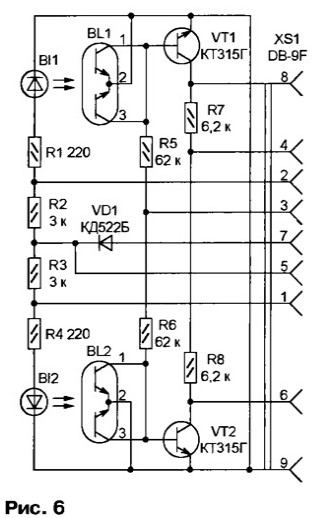
Socket XS1 BVK can be connected with both parallel and serial the computer's port. It is enough to prepare an appropriate cable according to the schemes, depicted in Fig. 7 (LPT port) or in Fig. 8 (to COM port).
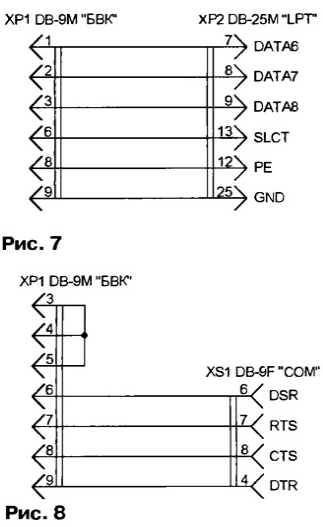
Shown in Fig. 5 and 8 sockets XS1 (DB-9F) are joined with the established modern computers plugs DB-9M port COM1. COM2 is usually provided with a plug DB-25M, the purpose of the contacts will be slightly different. Great variety of different connectors for serial and parallel ports of computers obsolete types, mainly produced in the USSR. The GDR and Poland. In all such cases have IOO to connect with the connector on the computer, focusing on figures the names of the port lines.
Let us return to Fig. 6. The current through the emitting LEDs VI and BI2 set by resistors R1 and R4 (when connected to LPT) or R1-R4 (when connected to COM). Emitters and corresponding photodetectors (BL1, BL2) are arranged so that optical coupling between them is interrupted, being in the proper position rocker push-button mechanism of the chess clock. For example, by holding down the right the button should not be able to communicate V-BL1, phototransistors Assembly should BL1 to be closed. While holding down both buttons (stop-clock), and lit opened phototransistors both assemblies (BL1 and BL2).
The experiments showed that the signals of the optical sensors is sufficient to reach direct feed to the inputs ports of the PC amplitude only at very the small distance between the emitters and photodetectors. Therefore, in BVK provided by the amplifier-inverter sensor signal transistors VT1 and VT2. Their collector loads when connecting to the COM port are the resistors R7 and R8. To work with the LPT port load resistors are not required. The VD1 diode - protective, in case of reverse polarity of the voltage on the RTS and DTR COM port.
The tower is assembled on the Board of fiberglass dimensions 95x15x1 As shown in mm. Fig. 9, this fee (4) pasted on the inside of the upper wall of the case "amber". All the details and the traces are on the free side of the Board. Her opposite ends of approximately 85 mm from each other and near the the corresponding buttons are 2 optical sensors 3. The distance between emitting diode and working together with him phototransistor Assembly - 6...8 mm. Other elements of the tower is installed on the PCB in such a way as not to impede the progress rocker arm 1.
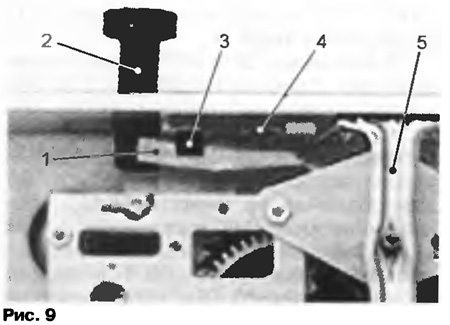
Socket XS1 mounted on a removable rear wall of the casing and connected to channels 4 wire harness 5. Due to the lack of Board space diode VD1 and resistors R1, R4 are soldered directly to the contacts of the socket. In IOO, designed for the only connection to the LPT port, Diode VD1 and the resistors R2, R3, R7, R8 can not install.
Items optical sensors - light emitting diodes and phototransistors - extracted from computer "mice" Genius Easy Mouse. When you replace them with similar devices from "mice" other types may need to select values of resistors: R1-R4 to set the current 8 mA 4...using light emitting diodes, and R5, R6, to achieve reliable triggering of the sensors.
The VD1 diode and transistors VT1, VT2 - any small. All resistors - MLT-0,125. Socket DB-9F can be replaced by SNP-9G or another, right the number of contacts and dimensions by modifying accordingly the cable plugs HR (see Fig. 7 and 8).
In conjunction with any of the remotes or keypad with IOO "E chess clock". For those interested the details of the algorithm of its work it also includes the source text in the language C.
The program is developed for operational system MS DOS and VGA video (640x480 peak), allowing it to run on "ancient" computers often idle gathering dust in the pantry. It is possible to work under Windows mode DOS emulation.
Immediately after the launch should be reported to the program method of controlling clock (buttons, optical sensors, ESC and ENTER keys on the computer keyboard) which of ports connected button or IOO (LPT1, LPT2, COM1, COM2) and select control time (hours delayed, "Bronstein clock", "clock Fisher", sand watch). It remains to specify the time allotted to each player for the entire game, and specify the amount of delay or increment time. All installation modes computer accompanies the tips. The main screen shown in Fig. 10, contains two round dials.
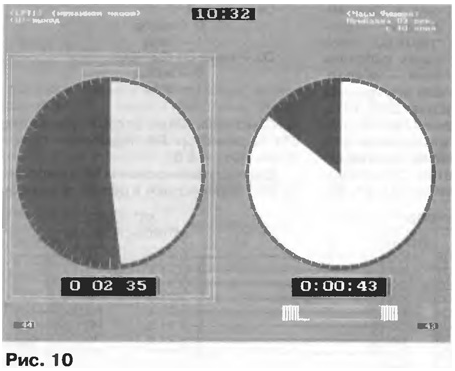
Counts as analog (spent time sector yellow and white colors, left - purple sector) and digital ways. On the scoreboard in the top of the screen display the current time - indications of the internal clock of the computer. Pressing 5 chess clock can be temporarily stopped and started again. Pressing 7 to adjust the values of the counter moves of any player (displayed on the lower corners of the screen). This may be required if the clock button is pressed mistakenly.
Once in stock the player has less than 1 min of time in the bottom of the screen under his dial appears white stripe "last mile", is gradually filling blue. It will be oriented in time trouble.
In accordance with FIDE regulations, the expiration of the time indicated by the stop stroke hours both opponents, beep and STOP caption on the screen. Fixed inherent to the game mechanical clock with the inability to determine the winner of the almost simultaneously fell "flags", when regardless of the position on the Board judges record a draw.
ESC-based computer can be applied in other games: checkers, sports bridge, go, Renju.
Literature
Author: S. Ryumik, Chernigov, Ukraine






